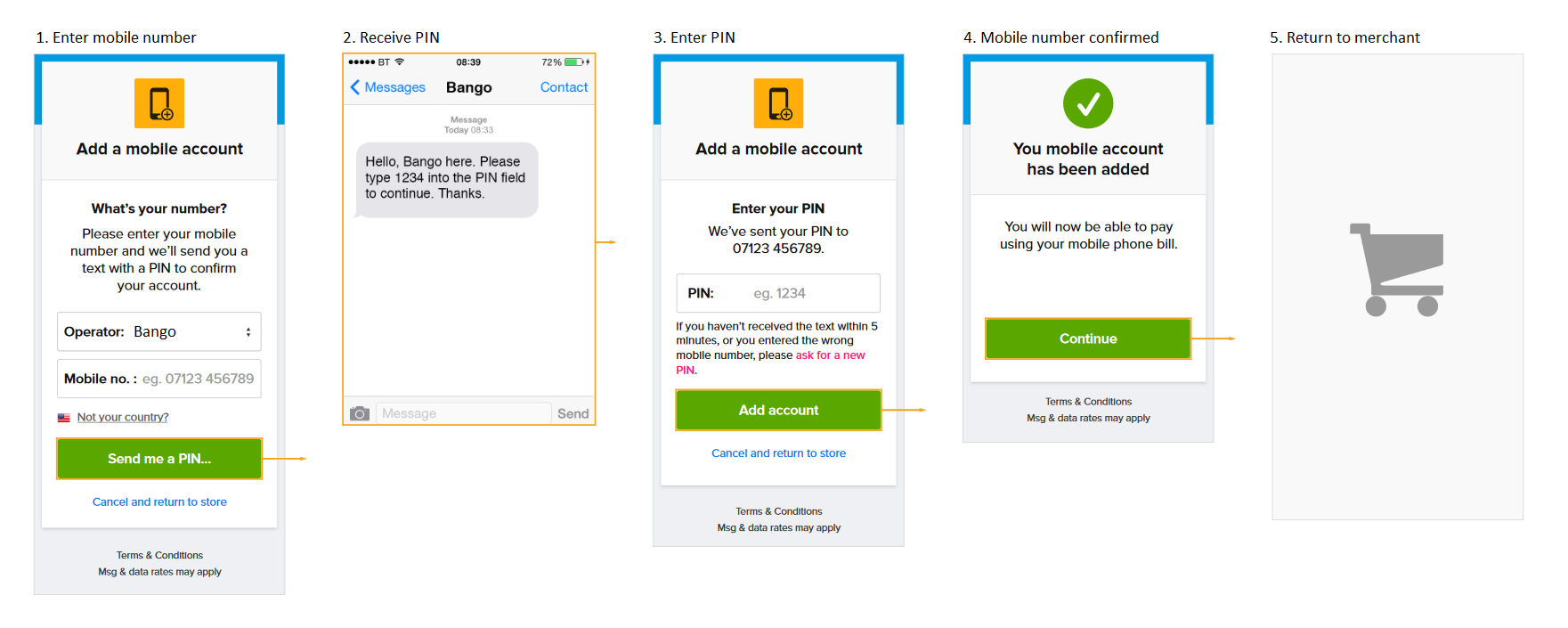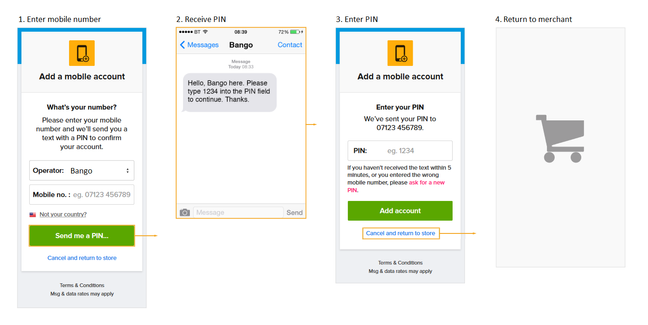1 User identification
Introduction
User identification can require one or more calls to the API depending on device capabilities and identification methods available.
Action | Possible responses |
|---|---|
Initial request sent to https://api.bango.net/v5/identity Example request: {
"deviceCapabilitySendSms": "true",
"identificationMethodKey": "{identification-method-key-provided-by-Bango}",
"callbackUrl": "{callback-url}",
"notificationUrl": "{notification-URL}"
}
|
Example reponse: {
"responseCode": "OK",
"responseMessage": "Success.",
"sessionId": "{sessionId}",
"parameters":
{
}
}
|
If 2 or more calls are required to complete the identification process, the session id returned in the first response must be appended to the URL for any subsequent calls.
Action | Possible responses |
|---|---|
Subsequent requests sent to https://api.bango.net/v5/identity/{sessionId} |
|
We recommend testing that different sequences of responses can be handled.
For example a WAIT may be returned at any stage if a user action or payment provider response is pending.
Redirect via Bango MT flow
1.1 URL redirect via Bango MT flow, then user identified
| Bango test details | ||
|---|---|---|
| identificationMethodKey | GBR_BANGO | This can be used to generate UserIds for non-redirect payment flow testing |
| identificationMethodKey | GBR_BANGOREDIRECT | This can be used to generate UserIds for redirect payment flow testing |
Test | Action | Expected result |
|---|---|---|
1 | Send a valid POST request to https://api.bango.net/v5/identity Optional: include a notificationUrl to be notified when the user completes the redirect process. E.g. {
"deviceCapabilitySendSms": "true",
"identificationMethodKey": "{identification-method-key-provided-by-Bango}",
"callbackUrl": "{callback-url}",
"notificationUrl": "{notification-URL}"
}
| An HTTP response code 200 (OK) should be returned with the following body: {
"responseCode": "CLIENT_ACTION_REQUIRED",
"responseMessage": "An action is required in the client.",
"sessionId": "{sessionId}",
"bangoUserId": null,
"parameters":
{
"action": "REDIRECT",
"url": "{redirect-url}"
}
}
|
| 2 | Send the user to the URL provided. | Bango identity flow: After the user has completed any manual actions required they should be sent to your specified "callbackUrl". The Bango API will also send a POST to the "notificationUrl" if one is provided in the initial request. {
"bangoUserId": {bango-user-id},
"identificationSessionId": {identification-session-id}
}
|
| 3 | When the user has reached the return URL resend the POST request to https://api.bango.net/v5/identity/{sessionId} | An HTTP response code 200 (OK) should be returned with the following body: {
"responseCode": "OK",
"responseMessage": "Success.",
"sessionId": "{sessionId}",
"bangoUserId": "123456789",
"parameters":
{
}
}
|
1.2 User cancels during redirect flow
Test | Action | Expected result |
|---|---|---|
1 | Send a valid POST request to https://api.bango.net/v5/identity E.g. {
"deviceCapabilitySendSms": "true",
"identificationMethodKey": "{identification-method-key-provided-by-Bango}",
"callbackUrl": "http://your.callback.url",
"notificationUrl": "{notification-URL}"
}
| An HTTP response code 200 (OK) should be returned with the following body: {
"responseCode": "CLIENT_ACTION_REQUIRED",
"responseMessage": "An action is required in the client.",
"sessionId": "{sessionId}",
"bangoUserId": null,
"parameters":
{
"action": "REDIRECT",
"url": "{redirect-url}"
}
}
|
| 2 | User cancels during redirect flow | User cancels on Bango Enter mobile number page: User cancels on Bango Enter PIN page: User redirected to the callback URL |
| 3 | Resend POST request to https://api.bango.net/v5/identity/{sessionId} | An HTTP response code 202 (Accepted) should be returned with the following body: {
"responseCode": "USER_CANCELLED",
"responseMessage": "The user cancelled the identification flow.",
"sessionId": "9c7b9891-c871-4dd5-bdcc-ac25ff2412b7",
"bangoUserId": null,
"parameters": {}
}
|
1.3 User does not return from URL redirect
This scenario could be caused by the user closing their browser or experiencing network connectivity issues.
Test | Action | Expected result |
|---|---|---|
1 | Send a valid POST request to https://api.bango.net/v5/identity E.g. {
"deviceCapabilitySendSms": "true",
"identificationMethodKey": "{identification-method-key-provided-by-Bango}",
"callbackUrl": "http://your.callback.url",
"notificationUrl": "{notification-URL}"
}
| An HTTP response code 200 (OK) should be returned with the following body: {
"responseCode": "CLIENT_ACTION_REQUIRED",
"responseMessage": "An action is required in the client.",
"sessionId": "{sessionId}",
"bangoUserId": null,
"parameters":
{
"action": "REDIRECT",
"url": "{redirect-url}"
}
}
|
| 2 | Resend POST request to https://api.bango.net/v5/identity/{sessionId} | An HTTP response code 200 (OK should be returned with the following body: {
"responseCode": "CLIENT_ACTION_REQUIRED",
"responseMessage": "An action is required in the client.",
"sessionId": "{sessionId}",
"bangoUserId": null,
"parameters":
{
"action": "WAIT"
"suggestedWaitTimeMilliseconds": "3600"
}
}
|
| 3 | Test that different sequences of responses can be handled in subsequent POST requests to https://api.bango.net/v5/identity/{sessionId} including 'NOT_AVAILABLE'. |
Redirect via Header enrichment URL
1.4 URL redirect via Operator for header enrichment, then user identified
| Bango test details | ||
|---|---|---|
| identificationMethodKey | GBR_BANGO | This can be used to generate UserIds for non-redirect payment flow testing |
| identificationMethodKey | GBR_BANGOREDIRECT | This can be used to generate UserIds for redirect payment flow testing |
Test | Action | Expected result |
|---|---|---|
1 | Send a valid POST request to https://api.bango.net/v5/identity Optional: include a notificationUrl to be notified when the user completes the redirect process. E.g. {
"deviceCapabilitySendSms": "true",
"identificationMethodKey": "{identification-method-key-provided-by-Bango}",
"callbackUrl": "{callback-url}",
"notificationUrl": "{notification-URL}"
}
| An HTTP response code 200 (OK) should be returned with the following body: {
"responseCode": "CLIENT_ACTION_REQUIRED",
"responseMessage": "An action is required in the client.",
"sessionId": "{sessionId}",
"bangoUserId": null,
"parameters":
{
"action": "REDIRECT",
"url": "{redirect-url}"
}
}
|
| 2 | Send the user to the URL provided. | Bango identity flow: After the user has completed any manual actions required they should be sent to your specified "callbackUrl". The Bango API will also send a POST to the "notificationUrl" if one is provided in the initial request. {
"bangoUserId": {bango-user-id},
"identificationSessionId": {identification-session-id}
}
|
| 3 | When the user has reached the return URL resend the POST request to https://api.bango.net/v5/identity/{sessionId} | An HTTP response code 200 (OK) should be returned with the following body: {
"responseCode": "OK",
"responseMessage": "Success.",
"sessionId": "{sessionId}",
"bangoUserId": "123456789",
"parameters":
{
}
}
|
1.5 User does not return from identification provider during URL redirect
Test | Action | Expected result |
|---|---|---|
1 | Send a valid POST request to https://api.bango.net/v5/identity E.g. {
"deviceCapabilitySendSms": "true",
"identificationMethodKey": "{identification-method-key-provided-by-Bango}",
"callbackUrl": "http://your.callback.url",
"notificationUrl": "{notification-URL}"
}
| An HTTP response code 200 (OK) should be returned with the following body: {
"responseCode": "CLIENT_ACTION_REQUIRED",
"responseMessage": "An action is required in the client.",
"sessionId": "{sessionId}",
"bangoUserId": null,
"parameters":
{
"action": "REDIRECT",
"url": "{redirect-url}"
}
}
|
| 2 | Resend POST request to https://api.bango.net/v5/identity/{sessionId} | An HTTP response code 200 (OK) should be returned with the following body: {
"responseCode": "CLIENT_ACTION_REQUIRED",
"responseMessage": "An action is required in the client.",
"sessionId": "{sessionId}",
"bangoUserId": null,
"parameters":
{
"action": "WAIT"
"suggestedWaitTimeMilliseconds": "3600"
}
}
|
| 3 | Test that different sequences of responses can be handled in subsequent POST requests to https://api.bango.net/v5/identity/{sessionId} including 'NOT_AVAILABLE'. |
1.6 User not identified
This scenario can be tested using Prefer Headers.
Test | Action | Expected result |
|---|---|---|
1 | Send a valid POST request to https://api.bango.net/v5/identity E.g. {
"deviceCapabilitySendSms": "true",
"identificationMethodKey": "{identification-method-key-provided-by-Bango}",
"callbackUrl": "http://your.callback.url",
"notificationUrl": "{notification-URL}"
}
| An HTTP response code 200 (OK) should be returned with the following body: {
"responseCode": "CLIENT_ACTION_REQUIRED",
"responseMessage": "An action is required in the client.",
"sessionId": "{sessionId}",
"bangoUserId": null,
"parameters":
{
"action": "REDIRECT",
"url": "{redirect-url}"
}
}
|
| 2 | Resend POST request to https://api.bango.net/v5/identity/{sessionId} Include the following headers in the request:
| An HTTP response code 502 (FAILURE) should be returned with the following body: {
"responseCode": "FAILURE",
"responseMessage": "The identity provider returned an unspecified failure."
}
|
General failure scenarios
1.7 No identification methods available
Test | Action | Expected result |
|---|---|---|
1 | Send a valid POST request to https://api.bango.net/v5/identity with an invalid identificationMethodKey E.g. {
"deviceCapabilitySendSms": "true",
"identificationMethodKey": "{invalid-identification-method-key}",
"callbackUrl": "http://your.callback.url",
"notificationUrl": "{notification-URL}"
}
| An HTTP response code 202 (Accepted) should be returned with the following body: {
"responseCode": "NOT_AVAILABLE",
"responseMessage": "Invalid Identification Method Key.",
"parameters": {},
"sessionId": null,
"bangoUserId": null
}
|
1.8 Invalid sessionId or session expired
Test | Action | Expected result |
|---|---|---|
1 | Send a valid POST request to https://api.bango.net/v5/identity E.g. {
"deviceCapabilitySendSms": "true",
"identificationMethodKey": "{identification-method-key-provided-by-Bango}",
"callbackUrl": "http://your.callback.url",
"notificationUrl": "{notification-URL}"
}
| An HTTP response code 200 (OK) should be returned with the following body: {
"responseCode": "CLIENT_ACTION_REQUIRED",
"responseMessage": "An action is required in the client.",
"sessionId": "{sessionId}",
"bangoUserId": null,
"parameters":
{
"action": "REDIRECT",
"url": "{redirect-url}"
}
}
|
| 2 | Resend POST request with an invalid sessionId to https://api.bango.net/v5/identity/{invalid-sessionId} | An HTTP response code 200 (OK should be returned with the following body: {
"responseCode": "NOT_FOUND",
"responseMessage": "Invalid session id or session expired."
}
|
1.9 Error response from identity provider
This scenario can be tested using Prefer Headers.
Test | Action | Expected result |
|---|---|---|
1 | Send a valid POST request to https://api.bango.net/v5/identity E.g. {
"deviceCapabilitySendSms": "true",
"identificationMethodKey": "{identification-method-key-provided-by-Bango}",
"callbackUrl": "http://your.callback.url",
"notificationUrl": "{notification-URL}"
}
Include the following headers in the request:
| An HTTP response code 202 (Accepted) should be returned with the following body: {
"responseCode": "FAILURE",
"responseMessage": "The identity provider returned an unspecified failure",
}
|
1.10 Connect error
This scenario can be tested using Prefer Headers.
Test | Action | Expected result |
|---|---|---|
1 | Send a valid POST request to https://api.bango.net/v5/identity E.g. {
"identificationMethodKey": "{identification-method-key-provided-by-Bango}",
"callbackUrl": "http://your.callback.url",
"notificationUrl": "{notification-URL}"
}
Include the following headers in the request:
| An HTTP response code 502 (Connect error) should be returned with the following body: {
"responseCode": "CONNECT_ERROR",
"responseMessage": "Connection error submitting the identification
request to the identity provider."
}
|
1.11 Connect timeout
This scenario can be tested using Prefer Headers.
Test | Action | Expected result |
|---|---|---|
1 | Send a valid POST request to https://api.bango.net/v5/identity E.g. {
"identificationMethodKey": "{identification-method-key-provided-by-Bango}",
"callbackUrl": "http://your.callback.url",
"notificationUrl": "{notification-URL}"
}
Include the following header in the request:
| An HTTP response code 502 (Connect timeout) should be returned with the following body: {
"responseCode": "CONNECT_TIMEOUT",
"responseMessage": "Connection timeout submitting the identification
request to the identity provider."
}
|
1.12 Unauthorized
This scenario can be tested using Prefer Headers.
Test | Action | Expected result |
|---|---|---|
1 | Send a valid POST request to https://api.bango.net/v5/identity E.g. {
"identificationMethodKey": "{identification-method-key-provided-by-Bango}",
"callbackUrl": "http://your.callback.url",
"notificationUrl": "{notification-URL}"
}
Option 1: Include the following header in the request:
Option 2: Include the following header in the request:
| An HTTP response code 401 (Connect error) should be returned with the following body: {
"responseCode": "UNAUTHORIZED",
"responseMessage": "Invalid access credentials."
}
|
1.13 Service unavailable
This scenario can be tested using Prefer Headers.
Test | Action | Expected result |
|---|---|---|
1 | Send a valid POST request to https://api.bango.net/v5/identity E.g. {
"identificationMethodKey": "{identification-method-key-provided-by-Bango}",
"callbackUrl": "http://your.callback.url",
"notificationUrl": "{notification-URL}"
}
Include the following header in the request:
| An HTTP response code 502 (Connect error) should be returned with the following body: {
"responseCode": "SERVICE_UNAVAILABLE",
"responseMessage": "The server is undergoing maintenance and is not
available. Please, try again later."
}
|
1.14 Internal error
This scenario can be tested using Prefer Headers.
Test | Action | Expected result |
|---|---|---|
1 | Send a valid POST request to https://api.bango.net/v5/identity E.g. {
"identificationMethodKey": "{identification-method-key-provided-by-Bango}",
"callbackUrl": "http://your.callback.url",
"notificationUrl": "{notification-URL}"
}
Include the following header in the request:
| An HTTP response code 502 (Connect error) should be returned with the following body: {
"responseCode": "INTERNAL_ERROR",
"responseMessage": "The server encountered an unexpected condition
which prevented it from fulfilling the request."
}
|


